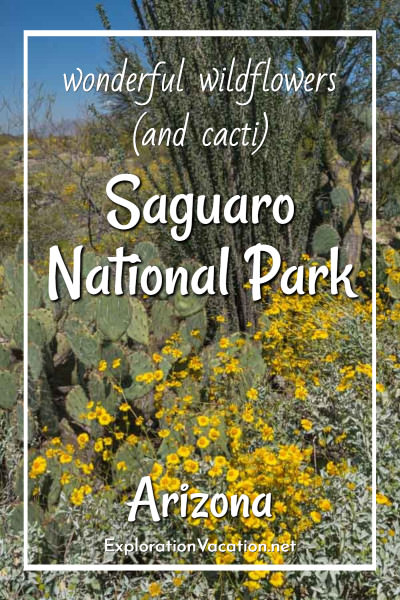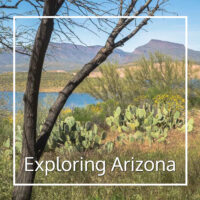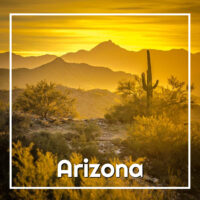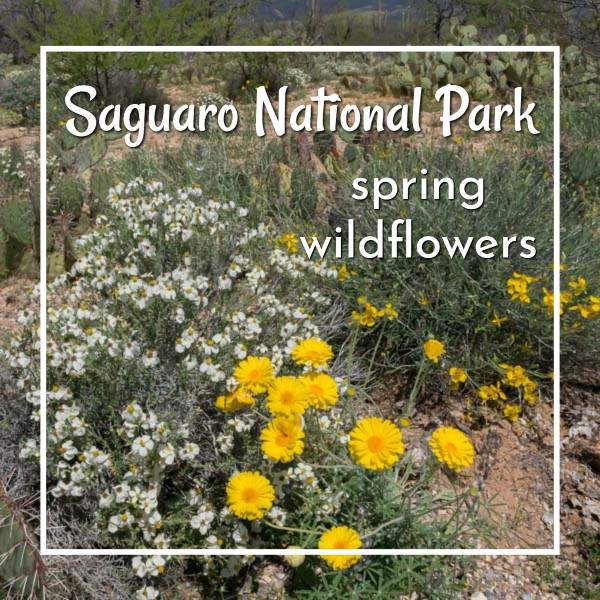Last updated on March 12th, 2023
While best known for towering saguaros, the large number of spring flowers in Saguaro National Park steal the show in March and April as the desert landscape explodes with color.

Arizona’s Saguaro National Park wildflowers bring a riot of color to the desert landscape.
Best of all, these colorful spring wildflowers can be found blooming along the road and trails throughout the park. That makes Saguaro National Park one of the easiest places to see spring wildflowers in Tucson.
When does Saguaro National Park bloom?
If you want to see a saguaro cactus in bloom, plan a visit to the Sonoran Desert in May or June. But if you want to see a wild mix of colorful spring flowers in Saguaro National Park, visit between mid-March and mid-April. This brief spring flower season is usually when you’ll find the greatest number and variety of desert wildflowers in bloom.

White desert zinnia (Zinnia acerosa) and the glowing orange blossoms of globemallow (Sphaeralcea ambigua) steal the show in spring – at least until the prickly pear, cholla, and other cacti put on their own show!
In Saguaro National Park flowers usually begin blooming in late February, with poppies and lupines are among to first to appear.

Cheerful California poppies (Eschscholzia Californica) usually start blooming in Saguaro National in Saguaro National Park in February.
By late March the spring wild flowers are in full bloom. The spring flower show ends with a wide variety of cactus blossoms in April and May before winding down as the heat of summer arrives in June.
Not that there aren’t a few flowers throughout the year. Some plants and cacti bloom in summer, often immediately after rain falls. And a rainy fall sometimes triggers a second flower season for a some spring-blooming wildflowers.
Every year will be different (and some years will have more wildflowers than others), but spring always bring a mix of flowers to the desert floor. The flower show will be better in wet years than in dry ones. However, while some annuals and herbaceous perennial wildflowers may sit out a particularly dry year, most cacti, shrubs, and trees flower every year.
Arizona wildflowers in spring
Despite often-harsh growing conditions, Saguaro National Park is home to something like 1200 plant species. Of course, not all of those plants bloom. But there area a lot of wildflowers in Saguaro park!
Spring wildflowers vary greatly in both size and color, so sometimes you really need to slow down and take a close look around. You might be surprised to see what is blooming on otherwise bare ground or in the shade of a cactus or tree.

Orange globemallow (probably Sphaeralcea ambigua), yellow Gordon’s bladderpod (Physaria Gordonii), and miniature blue woollystar (Eriastrum diffusum) sprawl over Saguaro’s seemingly barren desert soil.
Desert zinnia (Zinnia acerosa) is often found growing in and around cacti, including prickly pear.

Desert zinnia (Zinnia acerosa) often grow around prickly pears and other cacti.

Little fiesta flowers (Pholistoma Auritum) create a cloud of blue in a shady spot.
Other easy to spot spring flowers include:
- Parry’s penstemon (Penstemon parryi) has a long spring bloom season.
- Miniature woollystar (Eriastrum diffusum) is a small plant that sprawls on open soils.
- Desert chicory (Rafinesquia Neomexicana) is also known as New Mexico Plumeseed.
Of course, this is just a small sample of what you might see during a springtime visit to the park.
Flowering shrubs and trees may bloom longer
Some of the desert’s most common wildflowers are actually shrubs.
Brittlebush (encelia farinose) is common, colorful, and sure to bloom each spring. But if it rains, it will bloom at other times too. That makes it one of the flowers park visitors are most likely to see.

With its silvery mound of leaves, brittlebush (encelia farinose) is a handsome plant even when it isn’t in bloom, but it’s a show-stealer when covered with flowers!
While brittlebush wouldn’t look out of place in a backyard garden, a number of desert shrubs and trees have more unusual blossoms.
One of the strangest may be the fairy duster (Calliandra eriophyla), which often mixes with other flowering plants, including globe mallow.
With its wispy pink and white flowers fairy duster (Calliandra eriophyla) is lovely, if a bit odd.
But then, odd blossoms on trees and shrubs aren’t that unusual in the Sonoran Desert. When seemingly bland acacia trees bloom later in the season, they will look as if someone decorated them with tiny yellow powder puffs!
And then there is ocotillo (Fouquieria splendens).
While it looks like a cactus, ocotillo are woody shrubs. Tall, scraggly scrubs with sharp barbs along their stems, ocotillo often look dead. However, when it rains, they suddenly turn green and sprout leaves all along their spikey stalks. In spring those leaves are accompanied by bunches of little orange flowers at the very end of each stem.
Despite their spindly form, ocotillo (Fouquieria splendens) can add a lot of color to the landscape.
While their height makes it hard to get a good look at those tiny flowers (plants are usually more than 10 feet tall), they are striking plants when in bloom.
(If it’s been a wet year, ocotillo will bloom again in the fall, providing a second burst of color.)
So when do the cactus bloom in Saguaro National Park?
Thus far I’ve been focusing on desert wildflowers on woody and herbaceous plants.
But in the Sonoran desert spring flowers also include a wide range of blooming cacti and succulents.
Just not the Saguaro National Park’s namesake cactus. If you want to see a saguaro cactus bloom, you usually have to wait until late May or early June. That means the saguaro cactus flowers come well after most of the other cacti and wildflowers have finished blooming for the season.
But Saguaro National Park has many other types of cacti too, and some of these begin blooming while many spring wildflowers are still in bloom.
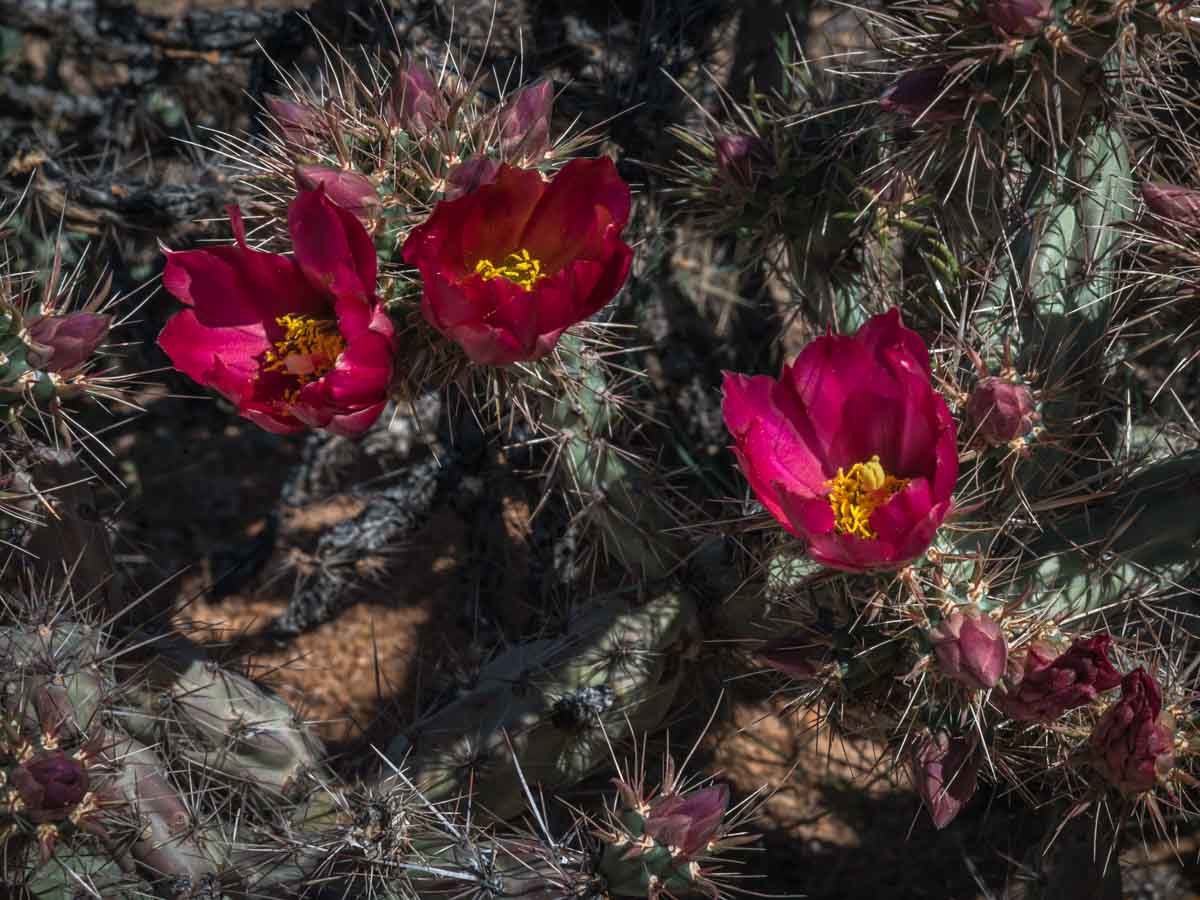
This may be a type of prickly pear cactus, but March is a little early for them to be in bloom.
Prickly pears can be found throughout Saguaro National Park. The earliest will start blooming in late March, while some varieties won’t bloom until June.
The is home to a wide variety of chollas. While it’s never advisable to get too close to a cholla, many produce beautiful flowers, including buckhorn cholla (Cylindropuntia acanthocarpa), Teddy bear cholla (Cylindropuntia bigelovii), tree cholla (Cylindropuntia imbricate), and staghorn cholla (Cylindropuntia versicolor). While I’ve seen these blooming at lower elevations in March, you’ll probably have to wait until sometime in April to see cholla bloom at Saguaro.
It’s easier to get a good look at a flowering hedgehog cactus (Cacti Echinocereus). Even though they are small plants, it’s hard to miss a hedgehog when it blooms, as the bright magenta flowers are almost as large as the cactus itself!

A trio of hedgehog cactus (Cacti Echinocereus) blossoms in Saguaro National Park.
Fortunately for spring flower fans, hedgehog cacti are both common in the Sonoran Desert and are among the earliest blooming cacti. That means they are usually in bloom along with the other spring wildflowers.
Plan your spring flower visit to Saguaro National Park
If you are looking for the brightest mix of colorful flowers in the Sonoran Desert, time your visit for mid-March through mid-April. Although the timing and quantity of flowers varies each year, this brief period usually offers both the most and the best mix of spring flowers — on woody and herbaceous plants as well as blooming cacti.
Mid-morning is the best time to look for flowers. Arrive too early and they haven’t opened yet. Arrive too late in the day and they may have already closed or wilted under the mid-day sun.
Where is Saguaro National Park?
Saguaro National Park is divided into two districts located to the east and west of Tucson, Arizona.
Tucson is roughly a 1 ½ hour drive southeast of Phoenix, although where you start and end can add or subtract at least a half hour from that estimate. It’s about a half-hour drive between the two park districts.
Where to look for spring flowers in Saguaro National Park
Both sections of Saguaro park have large visitor centers, a loop driving tour, picnic areas, and a variety of hiking trails. The larger Rincon Mountain District to the east also offers biking along the road and backcountry hiking.
Within the park, I found good stands of easy to view wildflowers in both the eastern Rincon Mountain and western Tucson Mountain districts. However, the blooming season in each part of the park is slightly different, mostly due to differences in elevation. When I visited in late March, I found quite a few cacti blooming in the Tucson Mountain District, where there were virtually none in the Rincon section. Both sections of the park had a good, if slightly different, mix of other wildflowers.
If you are looking for something particular, ask at either visitor center and they should be able to tell you if that plant is in bloom yet and where you might be able to see it.
And keep in mind, you are unlikely to see saguaro flowers until at least late April and usually not until well into May or even June.
As in any natural area, stay on the trail. This not only protects the flowers, but the desert itself. The Sonoran Desert is a surprisingly fragile environment, so even the most careful steps off the trail can cause real and lasting damage.
For more information on visiting Saguaro National Park, see Saguaro National Park: Two great Arizona parks.
Other places to look for spring wildflowers near Tucson
While Saguaro National Park is a great place to look for spring wildflowers, they can be found almost anywhere, including right along the highway. For example, taking Highway 79 down to Tucson, the area around Florence Junction is noted for multi-color displays of globemallow. I’ve also found dozens of different flowers right along State Highway 188 between Claypool and the Apache Trail. The key is to keep your eyes open and STOP, get out of your car, and look around. While some flowers are so bold you’ll notice them at 60 miles an hour, most require stopping and taking a close look. Just watch where you walk – that dry patch of gravel may be alive with flowers in another week! Always stay on trails when you leave the road.
Spring wildflowers are easy to find in and around Tucson. Look for flowers at Tohono Chul gardens, the Tucson Botanical Gardens, the Arizona-Sonora Desert Museum, Colossal Cave Mountain Park, and Catalina State Park — or along pretty much any desert road in March and April.
Between Tucson and Phoenix, there are always at least a few desert plants in bloom throughout the year at Boyce Thompson Arboretum State Park. The arboretum includes both natural areas and a variety of gardens with desert plants from around the world.
Resources for finding and identifying spring flowers
You can learn more about plants in Saguaro National park on the park’s website. However, the park is now posting either very general information or very detailed scientific data. Neither of which is much use to the general public.
If you want to know when and where to see wildflowers in Tucson, the Arizona wildflower report at Desert USA is the place to start. This website compiles first-hand reports of the wildflower and cactus bloom in Arizona. Check the Yuma and Tucson area wildflower finder for information on spring flowers in Saguaro National Park. (There’s a separate section on wildflowers in Phoenix and northern Arizona.)
In addition, local media often feature flower hot spots as the season progresses.
To identify plants in Saguaro National Park, check the Southwest Desert Flora website, the Wildflowers of Saguaro National Park page on the American Southwest website, or Southeastern Arizona Wildflowers and Plants photo identification pages.
The Arizona-Sonoran Desert Museum (located right by Saguaro National Park) has a section on the desert in bloom with lots of information on predicting spring bloom in the Sonoran Desert.
And, of course, both visitor centers at Saguaro National Park offer a lot of information on the plants that live in the park, including tips on what’s in bloom where.
Need a little desert beauty to brighten up your home or office? See more spring desert flowers and Saguaro National Park photos at CindyCarlsson.com.
